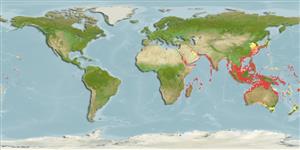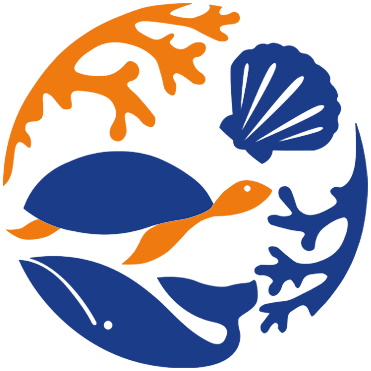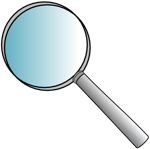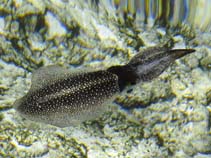Sepioteuthis lessoniana Férussac, 1831
Bigfin reef squid| Native range | All suitable habitat | Point map | Year 2050 |

|
| This map was computer-generated and has not yet been reviewed. |
| Sepioteuthis lessoniana AquaMaps Data sources: GBIF OBIS |
Classification / Names ชื่อสามัญ | ชื่อพ้อง | CoL | ITIS | WoRMS
Cephalopoda | Myopsida | Loliginidae
Environment: milieu / climate zone / ระดับความลึก / distribution range นิเวศวิทยา
สัตว์น้ำหน้าดิน; กร่อย; ระดับความลึก 0 - 100 m (อ้างอิง 275). Tropical; 51°N - 48°S, 22°E - 155°W (อ้างอิง 106950)
Distribution ประเทศต่างๆ | พื้นที่จำแนกตาม FAO | ระบบนิเวศหลายระบบ | การปรากฏขึ้น,การเกิดขึ้น,พบ | การแนะนำ
Indo-Pacific: from Japan to Australia and New Zealand coasts, from Hawaii to the East African coast, north to Red Sea and south to Madagascar. Introduced in the Mediterranean Sea.
Length at first maturity / ขนาด / Weight / Age
วัยเจริญพันธุ์: Lm ? range ? - ? cm Max length : 40.1 cm ML เพศผู้/กระเทย; (อ้างอิง 121859); น้ำหนักสูงสุดที่มีการรายงาน: 1.80 g (อ้างอิง 275)
Also caught by set nets and spears and jigs. Demersal neritic species (Ref. 105081). Inhabits warm coastal waters (Ref. 101164). Found among rock reefs, seaweeds and estuaries (Ref. 105081). Primarily active at night and is found in shallow waters, from 0 to 100 m in depth. Moves to deeper waters or in proximity to floating driftwood, reefs, rocks, or seagrasses during daylight (Also Ref. 129713). Often solitary (Ref. 101164). Voracious (Ref. 101165) and strictly carnivorous predator (Refs. 101164, 129713). Mainly consumes mollusks, fishes (Ref. 101164) and prawns (Ref. 101165). Utilizes its characteristic tentacles to catch live prey (Ref. 101164). Exhibits cannibalism on smaller conspecifics (Ref. 101164) or among size classes (Ref. 101165).
Life cycle and mating behavior วัยเจริญพันธุ์ | การสืบพันธุ์ | การวางไข่ | Eggs | ความดกของไข่ | Larvae
Members of the class Cephalopoda are gonochoric. Male and female adults usually die shortly after spawning and brooding, respectively. Mating behavior: Males perform various displays to attract potential females for copulation. During copulation, male grasp the female and inserts the hectocotylus into the female's mantle cavity where fertilization usually occurs. Life cycle: Embryos hatch into planktonic stage and live for some time before they grow larger and take up a benthic existence as adults.
Main reference
อ้างอิง | ผู้ประสานงาน | ผู้ร่วมมือ
Roper, C.F.E., M.J. Sweeney and C.E. Nauen. 1984. (อ้างอิง 275)
IUCN Red List Status
(อ้างอิง 130435: Version 2024-2)
Data deficient (DD) ; Date assessed: 02 July 2014
CITES status (อ้างอิง 108899)
Not Evaluated
CMS (อ้างอิง 116361)
Not Evaluated
Threat to humans
Human uses
การประมง: การค้า
FAO - การประมง: landings | FishSource | ทะเลรอบๆเรา
เครื่องมือ
ข้อมูลเพิ่มเติม
นิเวศวิทยาเขตร้อน
นิเวศวิทยา
Population dynamics
การเจริญเติบโต
Max. ages / sizes
Length-weight rel.
Length-length rel.
Length-frequencies
Mass conversion
การทดแทนที่
อุดมสมบรูณ์
Max. ages / sizes
Length-weight rel.
Length-length rel.
Length-frequencies
Mass conversion
การทดแทนที่
อุดมสมบรูณ์
Life cycle
Distribution
Human Related
Aquaculture profiles
Stamps, coins, misc.
Stamps, coins, misc.
Outreach
Taxonomy
อ้างอิง
แหล่งที่มาจากอินเตอร์เน็ต
BHL | BOLD Systems | CISTI | DiscoverLife | FAO(การประมง: ; publication : search) | Fishipedia | GenBank (genome, nucleotide) | GloBI | Gomexsi | Google Books | Google Scholar | Google | PubMed | แผนภูมิชีวิตแบบต้นไม้ | Wikipedia (Go, ค้นหา) | บันทึกทางด้านสัตววิทยา
Estimates based on models
Preferred temperature
(Ref. 115969): 23 - 29.1, mean 28 (based on 2210 cells).
ความสามารถในการกลับคืนสู่ปกติ
(Ref. 69278):
ความสูง, เวลาต่ำสุดที่จะทำให้ประชากรเพิ่มขึ้นเป็น 2 เท่าใช้เวลาน้อยกว่า 15 เดือน (K=0.73-1.25).
Nutrients : Calcium = 126 [75, 177] mg/100g; Iron = 4.79 [1.67, 7.92] mg/100g; Protein = 15.5 [13.7, 17.4] %; Omega3 = 0.414 [0.262, 0.566] g/100g; Selenium = 57.8 [48.5, 67.2] μg/100g; VitaminA = 0 μg/100g; Zinc = 1.97 [0.92, 3.02] mg/100g (wet weight); based on nutrient studies.



